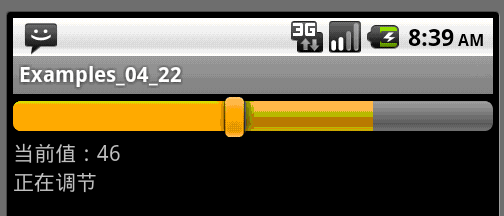【android基础学习之七】——常用效果2
声明:学习的书籍《Android应用开发揭秘》,这里记录学习该书籍的日志,引用的相关代码与总结描述,没有商业的用途,完全是自我学习的一个记录,刚刚学习不可避免会出现很多问题,若是有错误还请大家多多批评。
2011-10-30周日,继续《Android应用开发揭秘》的学习,接上一篇常用效果的学习;
一、 进度条(ProgressBar)
进度条作为后台程序处理过程中,反馈给使用者的一个很好的凭证,来显示当前程序处理的怎么样,进度如何等情况。Android中一共有两种样式进度条:长形进度条与圆形进度条。而且有的程序也可以在标题栏显示进度条。
在我们Eclipse开发android程序中,在编辑main.xml文件时,也提供了图形化界面的编辑,如下图:
实例分析:通过一个开始按钮的点击,显示圆形与长形进度条的进度。
关键源码:
main.xml布局文件:
<ProgressBar
android:id="@+id/ProgressBar01"
style="?android:attr/progressBarStyleHorizontal"
android:layout_width="200dp"
android:layout_height="wrap_content"
android:visibility="gone"
/>
<ProgressBar
android:id="@+id/ProgressBar02"
android:layout_width="wrap_content"
android:layout_height="wrap_content"
style="?android:attr/progressBarStyleLarge"
android:max="100"
android:progress="50"
android:secondaryProgress="70"
android:visibility="gone"
/>
【注意】该实例关键的是对ProgressBar的控制,之前例子中已经将过若是通过Handler实例的sendMessage()方法进而触发handleMessage(Message mesg)方法:
//当按钮按下时开始执行,
mButton01.setOnClickListener(new Button.OnClickListener(){
public void onClick(View v){
m_ProgressBar.setVisibility(View.VISIBLE);//设置ProgressBar为可见状态
m_ProgressBar2.setVisibility(View.VISIBLE);
m_ProgressBar.setMax(100); //设置ProgressBar的最大值
m_ProgressBar.setProgress(0); //设置ProgressBar当前值
m_ProgressBar2.setProgress(0);
//通过线程来改变ProgressBar的值
new Thread(new Runnable() {
public void run(){
for (int i = 0; i < 10; i++){
try{
intCounter = (i + 1) * 20;
Thread.sleep(1000);
if (i == 4){
Message m = new Message();
m.what = Activity01.GUI_STOP_NOTIFIER;
Activity01.this.myMessageHandler.sendMessage(m);
break;
}else{
Message m = new Message();
m.what = Activity01.GUI_THREADING_NOTIFIER;
Activity01.this.myMessageHandler.sendMessage(m);
}
}catch (Exception e){
e.printStackTrace();
}
}
}
}).start();
}
});
}
Handler myMessageHandler = new Handler(){
public void handleMessage(Message msg){
switch (msg.what){
case Activity01.GUI_STOP_NOTIFIER: //ProgressBar已经是对大值
m_ProgressBar.setVisibility(View.GONE);
m_ProgressBar2.setVisibility(View.GONE);
Thread.currentThread().interrupt();
break;
case Activity01.GUI_THREADING_NOTIFIER:
if (!Thread.currentThread().isInterrupted()){
m_ProgressBar.setProgress(intCounter);// 改变ProgressBar的当前值
m_ProgressBar2.setProgress(intCounter);
setProgress(intCounter*100); // 设置标题栏中前景的一个进度条进度值
setSecondaryProgress(intCounter*100);//设置标题栏中后面的一个进度条进度值
}
break;
}
super.handleMessage(msg);
}
};
实例效果:
二、 拖动条(SeekBar)
拖动条主要用于程序中,对一些属性的调节,如:音效大小。在Android中实现还是比较容易,SeekBar控件,而且只需要监听该控件的三个事件:
数值改变(onProgressChanged);
开始拖动(onStartTrackingTouch);
停止拖动(onStopTrackingTouch);
其控件配置也比较简单:
<SeekBar android:id="@+id/seek"
android:layout_width="fill_parent"
android:layout_height="wrap_content"
android:max="100"
android:progress="50"
android:secondaryProgress="75" />
效果图:
三、状态栏提示(Notification,NotificationManager)
当手机有未接电话或者短信息时,手机顶部状态栏就会显示一个小图标,用来显示用户有没有处理的快讯。NotificationManager用来管理状态栏的信息,而Notification用来处理这些快讯信息。
NotificationManager对象的获取通过gerSystenService方法,Notification对象可以设置其内容,图标,标题等属性。然后通过notify方法来执行一个Notification快讯。
实例分析:当用户点击一个按钮,就发出一个Notification快讯,这是手机顶部状态栏显示相应提示信息。展开状态栏,点击快讯信息,跳转到处理界面。
关键源码:
//初始化NotificationManager对象
m_NotificationManager = (NotificationManager) this.getSystemService(NOTIFICATION_SERVICE);
//获取四个按钮对象
mButton1 = (Button) this.findViewById(R.id.Button01);
mButton2 = (Button) this.findViewById(R.id.Button02);
mButton3 = (Button) this.findViewById(R.id.Button03);
mButton4 = (Button) this.findViewById(R.id.Button04);
//点击通知时转移内容
m_Intent = new Intent(Activity01.this, Activity02.class);
//主要是设置点击通知时显示内容的类
m_PendingIntent = PendingIntent.getActivity(Activity01.this, 0, m_Intent, 0);
//构造Notification对象
m_Notification = new Notification();
mButton1.setOnClickListener(new Button.OnClickListener() {
public void onClick(View v) {
//设置通知在状态栏显示的图标
m_Notification.icon = R.drawable.img1;
//当我们点击通知时显示的内容
m_Notification.tickerText="Button1通知内容..........";
//通知时发出默认的声音
m_Notification.defaults = Notification.DEFAULT_SOUND;
//设置通知显示的参数
m_Notification.setLatestEventInfo(Activity01.this, "Button1", "Button1通知", m_PendingIntent);
//可以理解为执行这个通知
m_NotificationManager.notify(0,m_Notification);
}
});
其中,notify()方法:
public void notify (int id, Notification notification)
Post a notification to be shown in the status bar. If a notification with the same id has already been posted by your application and has not yet been canceled, it will be replaced by the updated information.
Parameters
id |
An identifier for this notification unique within your application. |
notification |
A Notification object describing what to show the user. Must not be null. |
实例效果图:
四、对话框中的进度条(ProgressDialog)
对话框中的进度条,可以设置图标,内容等属性。
实例分析:通过点击两个按钮,显示对话框中得两种进度条。
关键源码:
//设置mButton01的事件的监听
mButton01.setOnClickListener(new Button.OnClickListener() {
public void onClick(View v) {
m_pDialog = new ProgressDialog(Examples_04_24Activity.this);//创建ProgressDialog对象
//设置进度条风格,风格为圆形,旋转的
m_pDialog.setProgressStyle(ProgressDialog.STYLE_SPINNER);
m_pDialog.setTitle("提示"); //设置ProgressDialog标题
m_pDialog.setMessage("这是一个圆形进度条对话框"); //设置ProgressDialog提示信息
m_pDialog.setIcon(R.drawable.img1); //设置ProgressDialog标题图标
m_pDialog.setIndeterminate(false); //设置ProgressDialog的进度条是否不明确
m_pDialog.setCancelable(true); //设置PrgoressDialog是否可以按退回键取消
m_pDialog.setButton("确定", new DialogInterface.OnClickListener() {//设置ProgressDialog的一个Button
public void onClick(DialogInterface dialog, int which){
dialog.cancel();
}
});
//让ProgressDialog显示
m_pDialog.show();
}
});
//设置mButton02的事件监听
mButton02.setOnClickListener(new Button.OnClickListener() {
public void onClick(View v) {
m_count = 0;
m_pDialog = new ProgressDialog(Examples_04_24Activity.this);//创建ProgressDialog对象
m_pDialog.setProgressStyle(ProgressDialog.STYLE_HORIZONTAL);//设置进度条风格,风格为长形
......
m_pDialog.show();// 让ProgressDialog显示
new Thread() {
public void run(){
try{
while (m_count <= 100){
// 由线程来控制进度。
m_pDialog.setProgress(m_count++);
Thread.sleep(100);
}
m_pDialog.cancel();
}catch (InterruptedException e){
m_pDialog.cancel();
}
}
}.start();
}
});
实例效果:
今天就实例效果学习结束了,关于android的学习,下面把布局学习结束后,基础的学习就结束了。加油!








